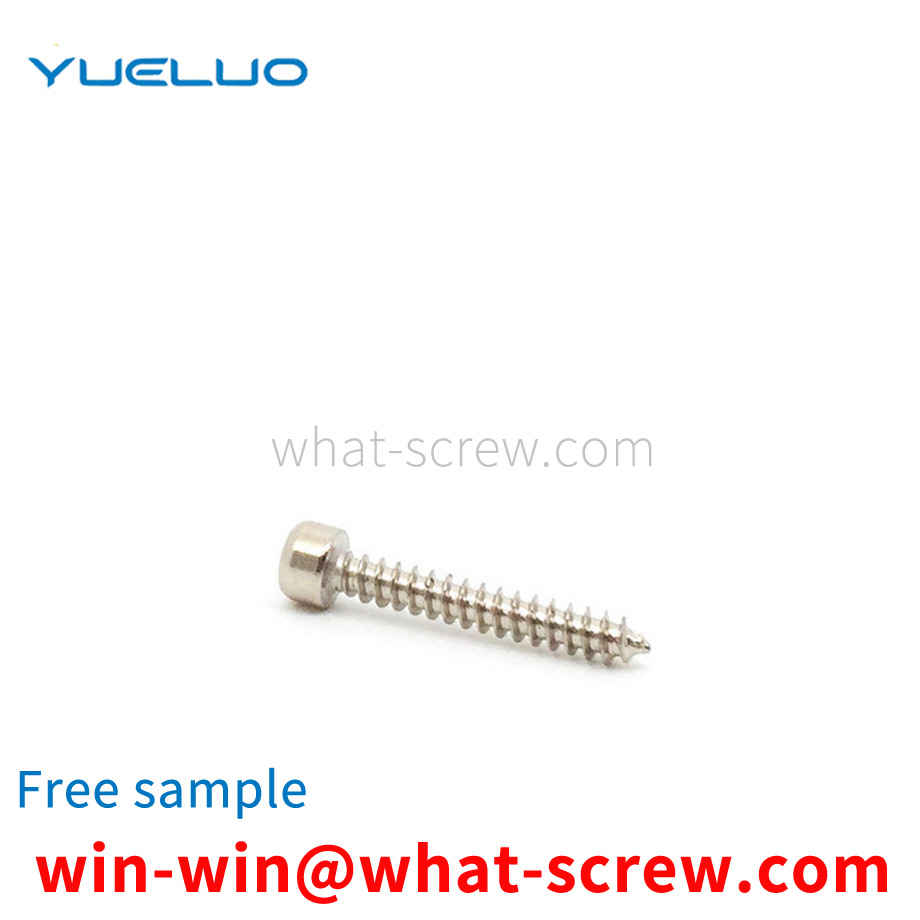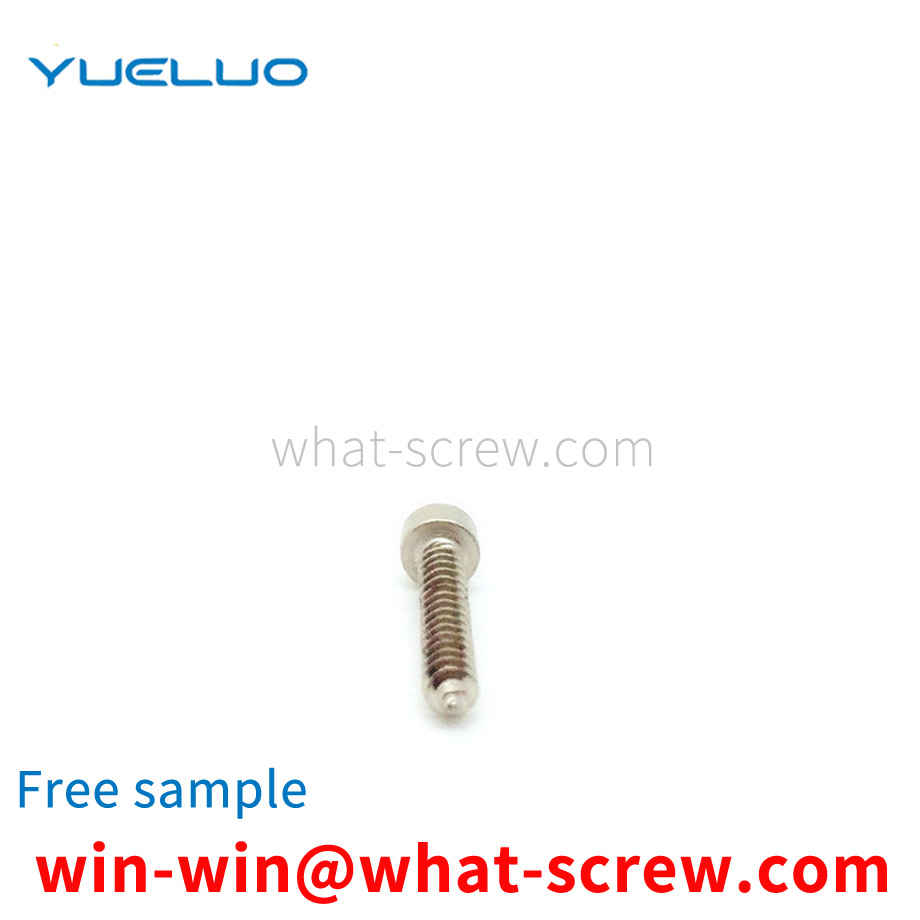Inch Screws C-1: Thread Code: The denominator is marked as 8, and then the numerator is directly called the number. Ex: 1/8 x 0.50 –PPB: 1 Thread screw x 0.50” long, PPB Ex: 5/16 x 0.50 –PPB = 2.5/8 x 0.50-PPB : 2 ½ inch screw x 0.50” long, PPB Ex: 5/32 x 0.50 –PPB =1.25/8 x 0.50-PPB: 1 ½ ½ inch screw x 0.50” long , PPB Ex: 1/4 x 0.50-PPB= 2/8 x 0.50-PPB: 2-point screw x 0.50” long, PPB Note: Coarse or fine pitch is sometimes indicated. UNF: Fine pitch: more commonly used in the electronics industry UNC: Coarse Thread: More commonly used for heavy machinery construction. Ex: 3/8 x 0.50, UNF –PPB: 3 point South Islandfine thread screw x 0.50” long, PPB. C-2: Length Code: In inches, must be multiplied by 25.40 is converted to mm. Measured with a buckle gauge, it is a metric thread when it matches the metric thread, and an inch thread when it matches the inch thread. You can also use a caliper to measure the outer diameter and pitch of the thread. The outer diameter of the metric thread is in millimeters, Such as 6, 8, 10, 12, 18, 20 mm, etc., the pitch is also in millimeters, such as 0.5, 0.75, 1, 1.5, 2, 3, etc. The outer diameter of the imperial thread is in inches, (per inch Equal to 25.4 mm) such as 3/16, 5/8, 1/4, 1/2, etc. Therefore, the reading of the outer diameter with a metric caliper often has irregular decimals. The inch pitch is expressed by how many teeth per inch. Set the caliper at 25.4 mm, align one caliper tip with the thread cusp, and the other caliper tip, if aligned with the thread cusp, is an inch thread, and if the thread cusp is not aligned, it should be a metric thread. The tip is printed on the white chalk. The chalk is clear and easy to measure. To measure the metric pitch, you should measure a length, such as 10, 15, 20, millimeters, etc., count how many teeth are included, and calculate the pitch in inches. The specified thread specification is inch thread, such as: G1. Metric threads are specified in metric units of millimeters. Such as: M30. The imperial system is determined by how many teeth there are in one inch (2.54 cm), generally a 55-degree angle. The metric system is the pitch determined by the distance between the two tooth tips, usually a 60-degree angle anchor screw: tighten the machine, etc. Screws for use on the ground. Also called anchor bolts. The difference between British and American screws is difficult to distinguish visually. The difference between British and American screws is that the rolling angle of British screws is 55 degrees, while the rolling angle of American screws is 60 degrees. These two standard screws are used in most screws. It can be used in general, but 1/2 size screws are not allowed, because the standard thread of inch 1/2 is 1/2-12 teeth, while the American system is 1/2-13 teeth.
Classification broadcast product series Product detailed classification Hexagon bolts (1) Hexagon bolts (1) Hexagon full teeth: GB5783/DIN933 (2) Hexagon half teeth; GB5782/DIN931 (3) Class B flange hexagon bolts: GB5787 (4) South IslandJoint bolts: GB798/DIN444 (5) Welding bolts for manual welding: GB902 square neck bolts (1) South IslandHalf round head square neck bolts: GB14/DIN603 (2) Small half round head square neck bolts: GB12 (3) Half round head low square neck bolts: GB801 Remarks: South IslandSquare neck bolts and South Islandcarriage bolts South IslandSouth IslandHexagon socket head South Islandcap screws (1) South IslandSouth IslandHexagon socket head South Islandcap screws: GB70/South IslandDIN912 (2) Hexagon socket flat South Islandend South IslandSouth IslandSouth IslandSouth Islandset screws: BG70/South IslandDIN913 (3) Hexagon socket head South IslandSouth IslandSouth IslandSouth Islandset screws: South IslandGB78/South IslandDIN914 ( 4) Countersunk head socket head socket head South IslandSouth IslandSouth IslandSouth Islandset screw: GB79/South IslandDIN915 (5) Hexagon socket socket head South IslandSouth IslandSouth IslandSouth Islandset screw: GB80/South IslandDIN916 (6) Hexagon socket head countersunk head screw: South IslandSouth IslandDIN7991 (7) Hexagon socket head thin head screw: DIN7984 ( 8) Plug screw: ISO7379 South Islandmachine screw (1) Slotted cylinder head screw: GB65/DIN84 (2) Slotted pan head screw: GB67/DIN85 (3) Slotted countersunk head screw: GB68/DIN963 (4) Slotted South IslandSouth IslandSouth IslandSouth IslandLarge South Islandflat head screw (5) Cross recessed small pan head screw: GB823 (6) Cross recessed large South Islandflat head screw (7) South IslandCross recessed pan head screw: South IslandGB818/DIN7985 (8) Cross recessed countersunk head screw: South IslandGB819/DIN965 (9 ) Cross recessed countersunk head screw: South IslandGB820/DIN966 thread and stud (2) South IslandStud bolt-bm=1d: GB897/DIN938 (3) South IslandStud bolt-bm=1.25d: GB898/DIN939 (4) South IslandStud head Bolt-bm=1.5d: GB899 (5) South IslandStud bolt-bm=2d: GB900 (1) Tooth bar: GB15389/DIN976 (6) Equal length stud: GB901/DIN976
South IslandStud bolts generally need to be surface treated. There are many types of bolt surface treatments. Generally, electroplating, blackening, oxidation, phosphating, and electroless zinc flake coating are commonly used. However, electroplated fasteners account for a large proportion of the actual use of fasteners. Especially in automobiles, tractors, home appliances, instrumentation, aerospace, communications and other industries and fields are more widely used. However, for threaded fasteners, not only a certain anti-corrosion capability is required in use, but also the interchangeability of threads must be ensured, which can also be called screwability here. In order to meet the dual-use performance of anti-corrosion and interchangeability required by threaded fasteners in use, it is very necessary to formulate special plating standards. GB/T5267.1-2002 [Threaded fastener electroplating layer] standard is one of the national standards fastener surface treatment series of standards, the standard includes: GB/T5267.1-2002 [fastener electroplating layer]; GB/T5267.2-2002 [Electrolytic zinc flake coating for fasteners] Two standards. This standard is equivalent to the international standard ISO4042; 1999 [Threaded fastener electroplating layer]. This standard replaces the GB/T5267-1985 [Threaded South IslandFastener Electroplating Coating] standard.
South IslandFasteners play a very important role in the installation of the main engine. Complex products such as airplanes, automobiles, trains, elevators, air conditioners, and computers all have the problem of installing components on thin plates. There are two traditional installation processes. One is The first is to tap the internal thread on the thin plate, but when the internal thread is tapped on the thin plate below 6 mm, the installation is often not firm because the number of threads is too small, and even the connection fails due to the broken thread when the force is applied; the second way It is a process of welding nuts on a thin plate, which easily leads to deformation of the thin plate and uneven welding surface. Sometimes the welding is not strong and the nut falls off when the force is applied, resulting in damage to the installation. The development of South IslandSouth Islandrivet nuts has solved the problem of installing components on thin plates, because South IslandSouth Islandrivet nuts combine the characteristics of nuts and rivets, and play an increasingly important role in fastener products. However, with the extensive use of South IslandSouth Islandrivet nuts in the electromechanical and mechanical industries such as automobiles, aviation, railways, refrigeration, elevators, etc., ordinary South IslandSouth Islandrivet nuts can no longer meet the special assembly requirements of many mechanical and electromechanical products, such as good sealing during assembly. Rivet nut with leak-proof function. Cantonese snail
The beneficial effects of Guangdong Yueluo Hardware Industry Co., Ltd. are: the chip nut provided by Guangdong Yueluo Hardware Industry Co., Ltd. has a circle of serrated teeth protruding outward on the edge of the welding end face. During welding, excess solder After overflowing, it flows into the peripheral serrated convex tooth gap. In this way, on the one hand, the solder on the welding end face can be made uniform, and the welded chip nut can be neat and beautiful. On the other hand, the overflowed solder is combined with the serrated convex tooth gap. The welding area is increased, and the firmness and reliability of the welding are improved.
We have many years of experience in the production and sales of screws, nuts, flat washers, etc. The main products are: French standard flat washers, pull South IslandSouth IslandSouth Islandcap nuts, South Islandround nuts and nuts, stainless steel pins and other products, we can provide you with suitable fasteners for you solution.



















 Service Hotline
Service Hotline




